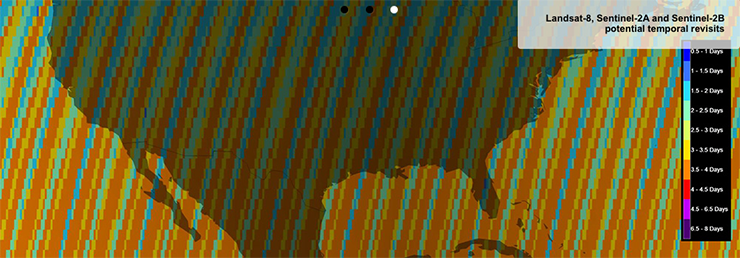Landsat 8 and Sentinel-2 satellites have spectral and spatial similarities that make using their data together possible. When the data are used together observations can be more timely and accurate. (Sensor co-calibration efforts were underway prior to Sentinel-2A’s launch.)
The HLS project is an effort to “harmonize” the data of the two satellite programs so that they can be more easily used in unison. The ultimate goal is to obtain seamless 2-3 day global surface reflectance coverage at 30 meters that removes residual differences between the sensors due to spectral bandpass and view geometry. Currently the v1.3 HLS data set encompasses 82 global test sites that cover about 7% of the global land area.

Using the processing power of the NASA Earth Exchange (NEX) computer cluster at NASA Ames, the HLS workflow atmospherically corrects data from the satellites, geographically tiles the Landsat data in a manor matching the Sentinel-2 tiling, and then corrects for different sensor view angles (Bidirectional Reflectance Distribution Function, or BRDF) and does a slight band pass adjustment for the Sentinel-2 data to create the harmonized 30-meter product.
The new HLS version 1.3 expanded the number of geographic test sites, fixed a bug that was causing incorrectly calibrated coefficients to be used when calculating spectral reflectance and another bug in the BRDF calculation. Version 1.3 also changed the band combination of its quick-look browse images to follow the USGS standard format (SWIR-1, NIR, Red) and it added quality assessments on a per-site basis in addition to the previous per-tile availability.
Currently, HLS data are only available for dates through April 30, 2017 because the HLS process relies on pre-collection L1T data.
The next version of HLS will include a wall-to-wall harmonized product for North America, and will migrate to routine weekly processing. The project anticipates releasing the new version (v1.4) by early 2018.
The HLS team includes researchers from NASA Goddard Space Flight Center, the University of Maryland, and NASA Ames Research Center.
Further Reading:
+ Harmonized Landsat Sentinel-2 website

Be Part of What’s Next: Emerging Applications of Landsat at AGU24
Anyone making innovative use of Landsat data to meet societal needs today and during coming decades is encouraged to submit and abstract for the upcoming “Emerging Science Applications of Landsat” session at AGU24.





